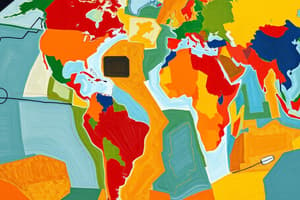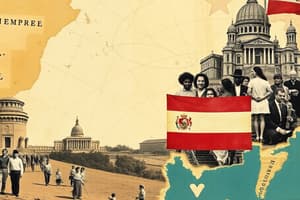Podcast
Questions and Answers
What was one reason that drove European nations to explore the Western Hemisphere?
What was one reason that drove European nations to explore the Western Hemisphere?
- To find a route to the North Pole
- Desire to establish permanent colonies in Asia
- Interest in developing friendships with Native Americans
- Search for new sources of wealth like gold and silver (correct)
What were the primary goods brought from the Americas to Europe and Africa during the Columbian Exchange?
What were the primary goods brought from the Americas to Europe and Africa during the Columbian Exchange?
- Honey and gold
- Silk and spices
- Potatoes, maize, and tomatoes (correct)
- Cattle and wheat
Which of the following accurately describes the Spanish Mission System?
Which of the following accurately describes the Spanish Mission System?
- Served as military outposts designed to convert Native Americans to Christianity (correct)
- Established cultural exchanges through artistic collaborations
- Promoted secular governance in the Americas
- Focused solely on establishing trade with Native Americans
What was one significant negative impact of the Columbian Exchange on Native American populations?
What was one significant negative impact of the Columbian Exchange on Native American populations?
What does the term '3 G’s' refer to in the context of European exploration?
What does the term '3 G’s' refer to in the context of European exploration?
What was a major consequence of Spanish exploration in the Americas regarding Native populations?
What was a major consequence of Spanish exploration in the Americas regarding Native populations?
Which system replaced the encomienda system in labor usage on plantations?
Which system replaced the encomienda system in labor usage on plantations?
Which technology significantly improved navigation during the Age of Exploration?
Which technology significantly improved navigation during the Age of Exploration?
What was a fundamental misunderstanding between Europeans and Native Americans?
What was a fundamental misunderstanding between Europeans and Native Americans?
Who argued for the fair treatment of Natives and played a role in ending the encomienda system?
Who argued for the fair treatment of Natives and played a role in ending the encomienda system?
Which crop was introduced to the Americas that significantly transformed Native life?
Which crop was introduced to the Americas that significantly transformed Native life?
What economic development was crucial for funding exploration in the 16th century?
What economic development was crucial for funding exploration in the 16th century?
What societal system categorized Europeans, Africans, and Natives during the Spanish colonial period?
What societal system categorized Europeans, Africans, and Natives during the Spanish colonial period?
What perspective did many Europeans have towards Natives and Africans during the colonization period?
What perspective did many Europeans have towards Natives and Africans during the colonization period?
What role did the horse play in the lives of Native Americans in the Great Plains?
What role did the horse play in the lives of Native Americans in the Great Plains?
What was one of the key cultural impacts of the Columbian Exchange on European societies?
What was one of the key cultural impacts of the Columbian Exchange on European societies?
Which of the following accurately reflects the socio-economic motivations behind European expansion into the Western Hemisphere?
Which of the following accurately reflects the socio-economic motivations behind European expansion into the Western Hemisphere?
Which statement best describes the dual nature of the impacts of the Columbian Exchange?
Which statement best describes the dual nature of the impacts of the Columbian Exchange?
Which of the following was NOT a primary goal of the Spanish Mission System in the Americas?
Which of the following was NOT a primary goal of the Spanish Mission System in the Americas?
What were the '3 G's' that motivated European exploration, and how did each impact societies involved in the Columbian Exchange?
What were the '3 G's' that motivated European exploration, and how did each impact societies involved in the Columbian Exchange?
Which statement accurately reflects a consequence of the Columbian Exchange in the Americas?
Which statement accurately reflects a consequence of the Columbian Exchange in the Americas?
What was a significant demographic change in Europe and Asia due to improved agricultural practices?
What was a significant demographic change in Europe and Asia due to improved agricultural practices?
Which of the following best describes the encomienda system?
Which of the following best describes the encomienda system?
In what way did the Spanish Caste System stratify society?
In what way did the Spanish Caste System stratify society?
What technological advancement was crucial for enhancing maritime navigation during the Age of Exploration?
What technological advancement was crucial for enhancing maritime navigation during the Age of Exploration?
Which factor contributed significantly to the decline of Native American populations after European contact?
Which factor contributed significantly to the decline of Native American populations after European contact?
How did European and Native American views on land ownership fundamentally differ?
How did European and Native American views on land ownership fundamentally differ?
What ideology did Juan de Sepulveda advocate regarding the treatment of Natives?
What ideology did Juan de Sepulveda advocate regarding the treatment of Natives?
Which of the following accurately reflects Bartolome de Las Casas' argument regarding Native treatment?
Which of the following accurately reflects Bartolome de Las Casas' argument regarding Native treatment?
What was a significant impact of the transatlantic slave trade on both Africa and the Americas?
What was a significant impact of the transatlantic slave trade on both Africa and the Americas?
Flashcards are hidden until you start studying
Study Notes
European Exploration
- European powers sought wealth through gold and silver, military competition, and the spread of Christianity.
- Key motivations include the defeat of the Spanish Armada igniting glory for England and Spain's aspiration to convert Native Americans.
Columbian Exchange
- Defined as the transfer of crops, animals, culture, humans, and diseases among the Americas, Europe, and Africa.
- Goods exchanged:
- From Americas to Europe: potatoes, maize, tomatoes.
- From Europe to Americas: wheat, rice, horses, chickens, oxen.
- Impacts:
- In Europe/Asia: population growth, wealth increase, decline of feudalism, rise of capitalism.
- In Africa: exploitation of West Africans for slavery in the Americas.
- In Americas: spread of diseases (smallpox, measles), emergence of social classes (Mestizos), transformation of Native life through horses.
Technology and Trade
- Innovations like the sextant, caravel, compass, and quadrant enhanced exploration accuracy and sailing efficiency.
- Joint-stock companies funded explorations, exemplified by investments in Jamestown (1607).
Spanish Exploration Impact
- European diseases decimated Native populations, killing up to 90% in some areas.
- Introduction of horses and new crops (wheat, rice, sugar) drastically changed Native lifestyles.
Encomienda System
- Native American labor was organized for agricultural work, later replaced by African slave labor.
- Laws in 1542 abolished the encomienda system.
Slave Trade
- Spanish and Portuguese traders enslaved individuals from West African groups for labor on plantations and mines.
Spanish Caste System
- Society structured hierarchically with Europeans (peninsulares and creoles) at the top, followed by Mestizos and Mulattos (mixed heritage).
Cultural Interactions
- Divergent worldviews created misunderstandings:
- Native societies often matrilineal, contrasted with European customs.
- Natives believed in communal land use versus European individual ownership.
- Natives practiced animism, while Europeans adhered to Christianity, leading to cultural exchanges.
Resistance and Autonomy
- Native populations sought to maintain their autonomy through diplomacy and military resistance against European encroachment.
Ethical Debates
- Conflicting views on treatment of non-Europeans arose:
- Juan de Sepulveda justified harsh treatment and slavery of Natives.
- Bartolome de Las Casas advocated for humane treatment, influencing the end of the encomienda system.
- Arguments used for subjugation included racism and religious justifications, framing Natives and Africans as "savage" or "barbaric."
European Exploration
- European powers sought wealth through gold and silver, military competition, and the spread of Christianity.
- Key motivations include the defeat of the Spanish Armada igniting glory for England and Spain's aspiration to convert Native Americans.
Columbian Exchange
- Defined as the transfer of crops, animals, culture, humans, and diseases among the Americas, Europe, and Africa.
- Goods exchanged:
- From Americas to Europe: potatoes, maize, tomatoes.
- From Europe to Americas: wheat, rice, horses, chickens, oxen.
- Impacts:
- In Europe/Asia: population growth, wealth increase, decline of feudalism, rise of capitalism.
- In Africa: exploitation of West Africans for slavery in the Americas.
- In Americas: spread of diseases (smallpox, measles), emergence of social classes (Mestizos), transformation of Native life through horses.
Technology and Trade
- Innovations like the sextant, caravel, compass, and quadrant enhanced exploration accuracy and sailing efficiency.
- Joint-stock companies funded explorations, exemplified by investments in Jamestown (1607).
Spanish Exploration Impact
- European diseases decimated Native populations, killing up to 90% in some areas.
- Introduction of horses and new crops (wheat, rice, sugar) drastically changed Native lifestyles.
Encomienda System
- Native American labor was organized for agricultural work, later replaced by African slave labor.
- Laws in 1542 abolished the encomienda system.
Slave Trade
- Spanish and Portuguese traders enslaved individuals from West African groups for labor on plantations and mines.
Spanish Caste System
- Society structured hierarchically with Europeans (peninsulares and creoles) at the top, followed by Mestizos and Mulattos (mixed heritage).
Cultural Interactions
- Divergent worldviews created misunderstandings:
- Native societies often matrilineal, contrasted with European customs.
- Natives believed in communal land use versus European individual ownership.
- Natives practiced animism, while Europeans adhered to Christianity, leading to cultural exchanges.
Resistance and Autonomy
- Native populations sought to maintain their autonomy through diplomacy and military resistance against European encroachment.
Ethical Debates
- Conflicting views on treatment of non-Europeans arose:
- Juan de Sepulveda justified harsh treatment and slavery of Natives.
- Bartolome de Las Casas advocated for humane treatment, influencing the end of the encomienda system.
- Arguments used for subjugation included racism and religious justifications, framing Natives and Africans as "savage" or "barbaric."
Studying That Suits You
Use AI to generate personalized quizzes and flashcards to suit your learning preferences.




